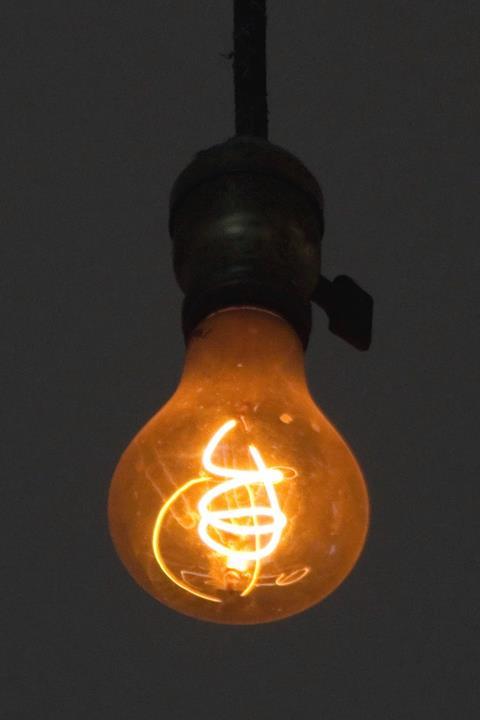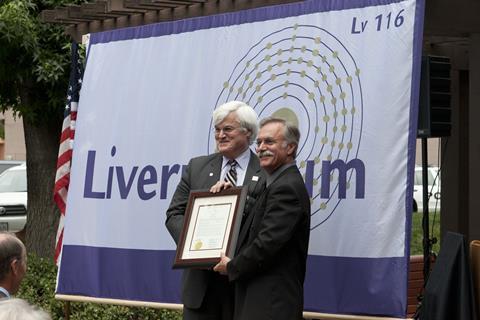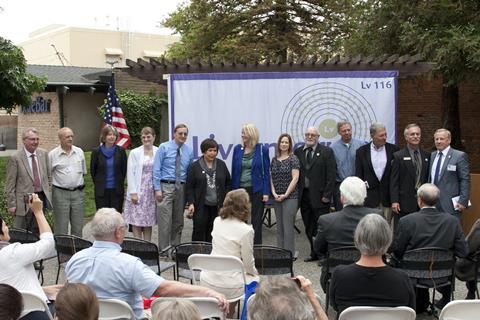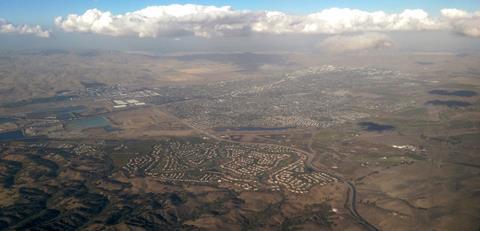Ben Valsler
Naming new elements is a complex process. There are strict rules, and discoverers often don’t get their first choice. But, as Kit Chapman discovered when he visited the Californian town of Livermore, the right name can make a difference beyond textbooks and periodic tables.

John Marchand
We are the oldest wine region in California. You may have heard of Napa? We buy autoparts at Napa, Livermore is where we make wine! Also, we have two national laboratories, so we are at the cutting edge of technology. We have, right now, the third fastest supercomputer in the world, within a year we'll have world's fastest once again. We also have the world's fastest rodeo...'

Kit Chapman
This is John Marchand. He's a chemist, and at the time I visited, Mayor of Livermore, a city in Calfornia's golden wine country just outside the San Francisco Bay. He's a bit proud of his home.
John Marchand
'We also have the world's largest laser at the national ignition facility, 192 40cm2 lasers. When that fires there is more energy being produced than is being used across the entire United States. We have the world's longest continuously burning lightbulb; it has been burning for 116 years.'
Kit Chapman
In 2012, Marchand had an entirely new reason to be proud. Scientists from the nearby Lawrence Livermore National Laboratory, in collaboration with a team at the Joint Institute for Nuclear Research in Dubna, Russia, had just been confirmed as the discoverers of elements 114 and 116. The names chosen were flerovium and livermorium.

In 1949, when the Mayor of Berkeley heard that his city would have an element named after it, he had practically put the phone down on the discoverers, utterly uninterested. It's fair to say Marchand's reaction was a little different.
John Marchand
Being a chemist, having an element named after my city, and then having the opportunity to go back to Moscow to the naming ceremony – at the Central Science Club in Moscow – was literally the high point of my career.
Kit Chapman
At the extremes of the periodic table, it's easy to forget why names have such importance. Livermorium itself is still largely a mystery. Made from shooting calcium into a curium target, its longest-lived isotope lasts a mere 57 miliseconds, so no chemistry has ever been performed on it. But unlike the isotopes, the names last forever.
IUPAC's rules are clear. An element can only be named after a property, a mythical creature, a location, a scientist or a mineral. In the modern era of discovery, all of the elements have been named after places or scientists. Livermorium is the heaviest element known to be named after a town – Tennessine is named after a state, and oganesson is after a scientist. Marchand wasn't going to let the opportunity for recognition go to waste. While we were chatting we were eating ribs across the street from a small park, its benches were decorated by local graffiti representing different aspects of the periodic table.

John Marchand
Livermorium Plaza is 116 Livermore Avenue. So what I want to do is to have a piece of public art there, so that when people come in they understand this is a special place, we have a special collaboration. We were originally looking at doing a signature sculpture piece. In Tomorrowland they have a floating marble ball. Well how cool would it be to have that in Livermorium plaza? That is the nucleus, and then you have 116 sponsored bronze disks around it. Wouldn't that be cool?
Kit Chapman
It's a neat idea – using scientific prestige to engage the community in life's greater mysteries. When the plaza was created, Marchand invited his opposite number from Dubna over for the naming ceremony. The two cities have formed close ties and, with dubnium as element 104, these ties will last long after both men are gone.
John Marchand
When Mayor Proke came out here to name Livermore plaza, he made the point there may come a time when Livermore and Dubna no longer exist, but as long as there is human knowledge we will exist on the periodic table of elements.

Ben Valsler
John Marchand, mayor of Livermore, talking with Kit Chapman about element 116, livermorium. There’s just two more elements to go until we’re fully up to date with the periodic table, and next time we step up from a Californian town to US state.
Kit Chapman
Tennessee has a long history of ties to the elements. It was home to the first permanent nuclear reactor, used to create the top secret plutonium for the first atomic bombs . In 1945, scientists at Oak Ridge, the secret city home to the reactor, discovered promethium, filling the last gap in the periodic table.
Ben Valsler
And this relationship is now enshrined forever, as Kit Chapman tells the tale of tennessine in the next Chemistry in its element podcast. Until then, get in touch with any questions or comments – email chemistryworld@rsc.org or tweet @chemistryworld. I’m Ben Valsler, and I’ll be back very soon.
Ununhexium
Our original podcast on elements 116 and 118, by Andrea Sella, was written long before livermorium had been named. We've saved it here for posterity:
This podcast was originally written to include elements 116 and 118. Since this podcast was first published, the names of these elements have been ratified by the International Union of Pure and Applied Chemistry (Iupac). Element 116 is now called livermorium (symbol Lv) in honour of the Lawrence Livermore National Laboratory in California, home of the US end of the collaborative team and a stalwart of nuclear and heavy-element research; element 118 has been named oganesson (Og) after its discoverer, Yuri Oganessian.
Meera Senthilingam
This week the chemist's that are seeking fame. Here's Andrea Sella
Andrea Sella
We live in an age when everyone is just gagging to be 'famous'. Andy Warhol, of course, pointed out that everyone was likely to be famous for 15 minutes. But the real question is, if you're a chemist, or a scientist generally, what does it take to become famous? How do earn the adulation of the masses? And if not the masses, at least of your peers?
You'd think a Nobel prize would do it. But you'd be surprised how few of them anyone can actually remember, apart from a few early 20th century heroes. And to have an element named after you need to be dead. So that seems quite pointless.

What if you discovered a new element? For about 70 years, ever since plutonium slipped out of a nuclear reaction, the search has been on to make ever heavier and more exotic elements to add to our periodic table. And I emphasise the word 'make' because it is no longer a question of finding a rock and extracting from it some mysterious substance that does not fit the description of anything that has come before. No, you actually have to make it from scratch.
So how do you make an element? Well new atoms of, admittedly old, elements, are being made all the time. Nuclear fusion of hydrogen is the fundamental process that powers stars. But as stars age and steadily run out of hydrogen they gradually start fusing heavier nuclei and it is then possible to make ever heavier atoms. It's brutally difficult because you have to get past the huge positive charges of the two nuclei to get them to fuse. Stars can do this nucleosynthesis up to iron. Unfortunately that's where things end.
After that the way to make anything heavier is by adding neutrons. Because the neutron has no charge it can sneak quietly into the nucleus. The neutron can then add to the total mass count, and the nucleus can then decay by spitting out an electron to give you something that is one place higher along in the periodic table. And repeating this process laboriously – one step forward, one step back – will take you all the way out towards uranium, which at atomic number 92 is about as high as one can find lying around in universe.
But can one go beyond? The answer turns out to be yes. Teams in the US, Germany, Japan and Russia have been hard at work doing it. And the process is incredibly difficult. Essentially what they do is strip atoms down to their nuclei and then accelerate them to phenomenal speeds using a particle accelerator, and then slam these ions into a target. So for example the element lawrencium was made by bashing a californium target with naked boron nuclei.
This is not work for the lone experimenter working in a shed somewhere. These are experiments of extraordinary subtlety and complexity. And the problem is not just making the new element but also figuring out what you've got at the end. The problem is that you only make a few atoms at a time and these products tend to be spectacularly unstable so you sometimes have only a few milliseconds in which to work out what you've got. It's complex. It's expensive. And very, very clever. And each new atom really is a whole new chemical world to explore. Can it be any wonder that it attracts fortune seekers?

In June 1999 the Lawrence Berkeley Lab in California, one of the few places in the world that does this sort of work announced in the journal Physical Review Letters that they had succeeded in making ununhexium and ununoctium, which in plain English means elements 116 and 118, by bashing a lead target with krypton nuclei. Huge excitement followed because these were by far the heaviest elements ever made. It seemed a real breakthrough. The method they had used was also a departure from previous work - a new strategy that had gone spectacularly well. The secretary of energy, whose department had funded the work noted that four of the senior members of the team were foreign said 'this stunning discovery which opens the door to further insights into the structure of the atomic nucleus also underscores the value of foreign visitors and what the country would lose if there were a moratorium on foreign visitors at our national labs. Scientific excellence doesn't recognise national boundaries, and we will damage our ability to perform world-class science if we cut off our laboratories from the rest of the world.'
The problem was however, that no one else could repeat the work. Labs in Germany and Russia reported that they got different results. A major process of soul-searching started in California and the data began to be picked over in great detail. A painful investigation concluded that one of the team leaders Victor Ninov, a Bulgarian national, had fabricated the crucial data. Confronted with the evidence, Ninov denied everything. But in Germany, irregularities came to light in the data associated with an earlier discovery he had been involved with – that of elements 111 and 112. Ninov was fired. The Berkeley led group were then forced to do the unthinkable – to publish a retraction, the author list being one name shorter than the original paper. It was the scientific equivalent of hara kiri.
But did element 116 really not exist? In 2000, the rival group in Russia reported having made a single atom of element 116 and within 3 years had succeeded in making more atoms of two different isotopes of this element. 118, on the other hand, had to wait until 2002 for successful synthesis by a route that differed from that used by the Americans. So 116 and 118 are real, and their properties are slowly being mapped out even as we speak. But does anyone remember the names of the people who are the rightful discoverers? Does the name Oganessian ring a bell? Probably not.
It's more likely that you remember the name of Victor Ninov, the man at the centre of the storm. Perverse, isn't it? But it's the way of the world. Fame, even in science, is a fickle mistress.
Meera Senthilingam
Perhaps the net aim then, rather than finding an element could be to find a way to preserve these legacies. Just a thought. That was University College London's Andrea Sella with the fundamental, not famous, chemistry of elements 116 and 118. Now next week a two faced element.
David Read
Sodium, like most elements in the periodic table could be said to have a dual personality. On one side it is an essential nutrient for most living things, and yet, due to its reactive nature is also capable of wreaking havoc if you happen to combine it with something you shouldn't. As such sodium is found naturally only in compounds and never as the free element. Even so it is highly abundant, accounting for around 2.6 per cent of the Earth's crust by weight.
Meera Senthilingam
And to find out some of the beneficial, as well as lethal roles of sodium – as well as the mystery behind it being given the symbol Na, join David Read from the University of Southampton in next week's Chemistry in its element.













No comments yet